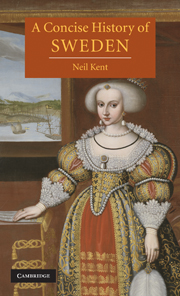Book contents
- Frontmatter
- Contents
- List of illustrations
- Maps
- Preface
- 1 From prehistory to Viking hegemony
- 2 The formation and growth of the Swedish state
- 3 The territorial consolidation of Sweden
- 4 Towards a centralist and military state
- 5 The collapse of absolutism and the Age of Freedom
- 6 Royal absolutism restored
- 7 Constitutional Sweden
- 8 The industrialisation and capitalisation of Sweden
- 9 The world wars and Swedish neutrality
- 10 Triumph of the Swedish welfare state
- Conclusion
- Appendix 1 Chronology
- Appendix 2 Monarchs and regents of Sweden
- Appendix 3 Prime ministers
- Selected further reading
- Index
3 - The territorial consolidation of Sweden
Published online by Cambridge University Press: 05 June 2014
- Frontmatter
- Contents
- List of illustrations
- Maps
- Preface
- 1 From prehistory to Viking hegemony
- 2 The formation and growth of the Swedish state
- 3 The territorial consolidation of Sweden
- 4 Towards a centralist and military state
- 5 The collapse of absolutism and the Age of Freedom
- 6 Royal absolutism restored
- 7 Constitutional Sweden
- 8 The industrialisation and capitalisation of Sweden
- 9 The world wars and Swedish neutrality
- 10 Triumph of the Swedish welfare state
- Conclusion
- Appendix 1 Chronology
- Appendix 2 Monarchs and regents of Sweden
- Appendix 3 Prime ministers
- Selected further reading
- Index
Summary
FAILURE OF THE NORDIC UNION AND THE RISE OF GUSTAF VASA
The final collapse of the Nordic Union led, in the decades which followed, to the consolidation of the country as a territorial state. It joined the ranks of the other emerging European states under the leadership of Gustaf Vasa (1496–1560), against the backdrop of the Protestant Reformation which he successfully utilised for his own political purposes. In January 1521, this powerful magnate, a close relation to Kristina Gyllenstierna (1494–1559), the widow of the late regent Sten Sture the Younger, who had escaped from Danish captivity two years before, had been elected leader of the disgruntled Dalecarlians, many of whom had supported the Stures. Attacked by Didrik Slagheck, the new pro-Danish governor in Stockholm, at the ferry crossing nearby at Brunnbäck, Vasa was victorious in his resistance and proceeded to crush Gustaf Trolle, Archbishop of Uppsala (1488–1535), on his own territory in Uppland. Winning, therefore, the support of most of the Council of State, Gustaf Vasa was elected its leader in August 1521. By the following year, much of Sweden had been secured, albeit not the key cities of Stockholm and Kalmar, nor the Finnish fortresses. In this the Hansa League came to his aid, but only on condition that its ships would be granted freedom from duties in Sweden and a promise that Swedish ships would remain in Baltic waters rather than compete for trade now carried by the Hansa. Bolstered by their support and the growing general opposition to Christian II of Denmark in wide segments of the population, Gustaf was able to bring almost all of Sweden under his control by the late spring of 1523. In consequence of these circumstances, he was elected king of Sweden, at Strängnäs, on 6 June of that year. If his alignment with the Hansa had paid dividends, a rebellion in Denmark, fomented by the Hansa, had also aided him, since it further undermined the already weakened and contested kingship of Christian II in that country. As a result, the latter’s uncle, Duke Frederik of Schleswig-Holstein, had been able to secure the throne, which he ascended as Frederik I, and Christian himself had been forced to flee the country.
- Type
- Chapter
- Information
- A Concise History of Sweden , pp. 49 - 60Publisher: Cambridge University PressPrint publication year: 2008



